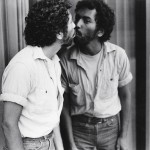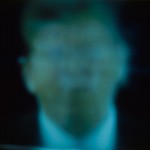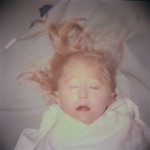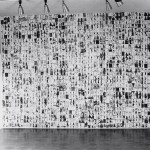My background is as a fine art photographer and today I’d like to talk about photographic work and its propensity to the series. Sometimes the art in photography is the series as in an image book, sometimes the art consists of individual works that together become a series, sometimes the series is all taken together as one individual work as in a collage or installation. These categories clearly aren’t rigid and become even more complicated as we think about media and curatorship and publication, i.e. who in fact decides on the series. Perhaps it is in the artist’s imagination (as in the work of August Sander) or perhaps it is an impulse post-fact of a third party who upon viewing the work finds threads of meaning (as often happens in curated retrospectives). This topic comes up for me not only because I certainly struggle with it in my own photography, but I also have had the opportunity to explore the exhibition Under the Big Black Sun at MOCA Los Angeles in depth for the last few weeks, especially several series of photographs created during the late 1970s and early 1980s.
Lets start by talking about the artistic process, although diversity among artists makes this by no means a simple trajectory. Personally, I begin often with an image or a thought, that thought transforms into an image or the image transforms into a thought. From there I explore the thought further with more images or explore the image further by expanding my sights. Sometimes this leads to a group of images that all look somewhat similar but truly were conceived individually, and sometimes this means that I come up with a group of images that only together fully realize the original intention. At other times I find myself exploring images that may be disparate and because of some level of chance perhaps, I find that they work together to express some other idea that I hadn’t even considered during exposure. These become an image in themselves, a collage made up of individual images that may or may not have been used in other projects previously but that now function as pieces of this new whole.

August Sander
It is common for artists of all media to work in series. Some painters have a general theme or utilize a unique process to create a series, but generally each of these works stand on their own. For photographers it is a little more difficult because often the end result of our work is realized in multiple forms (and multiplicity!). Photographic work may end up on an album cover, in a book, on a poster, it may be reproduced endlessly, it may be limited to a production run, or it may be completely unique. In this way, the series become far more important to the idea and function of photographic work than it is in other media. An artist like August Sander, who I mentioned earlier, conceived of his great project as a massive series documenting types of German people. This work was displayed as a series by Sander and printed into book form under his watch, but it was only through the utilization of his images as individual portraits and art pieces under the curation of Edward Steichen (in The Family of Man) and others that the idea and identity of Sander as auteur was born. The artistic acclaim of Sander as artist/image-maker was created through downplaying the staunchness of his own categorization of photographs within a series. Under the Big Black Sun offers us the possibility to directly compare different way of working with photographic art as/within the series.

Joe Deal
Separated in the museum space but conceptually quite similar, the works of Chauncey Hare, Joe Deal, and Lewis Baltz all utilize the series in a similar way. Hare photographed people as if they were office fixtures for his series “This Was Corporate America” from 1976-77. These black and white works each depict an office worker as a cog within the space wherein they work, surrounded by typical office paraphernalia from the ubiquitous file folders to the glaring lamps and cubical partitions, humanity sometimes confined to a portion of a head peeking up over the furniture as they become completely overwhelmed by the surrounding workspace. Deal’s series, “Diamond Bar: Recently Occupied Homes” from 1980 depicts the tell-tale signs of suburban occupation and development so prevalent during this period. Carefully manicured backyards fight to maintain their composure against the unoccupied chaos of neighboring grounds. Similarly but with a more clear political bent to his series, Baltz depicts the same expansion of humanity in “The New Industrial Parks Near Irvine” from 1974. These works more

Lewis Baltz
clearly juxtapose the stark walls of new development against the rambling weeds of the formerly natural grounds. All three of these photographers make a point by combining a grouping of similar photographs all shot with the same intention and always meant to be a part of the same series. Whereas these works on their own may hold some power and beauty, the political or ideological intention of the photographer is only really realized through their combination.
Another path may be seen through the works of Gronk, Hal Fischer, and Jim Goldberg, again separated spatially in this exhibition but similar in many ways from the way they use the series to, in the case of Fischer and Goldberg, their combination of text and image, and, in the case of Gronk and Fischer, their thematic

Hal Fischer
similarity. Gronk, who is better known for his large-scale mural work, created a series of black and white photographs from 1972 to 1978 that explored his life, world, and identity as a gay man. Fischer’s series, “Gay Semiotics: A Photographic Study of Visual Coding among Gay Men,” created in 1977, explored the modes of non-verbal communication in San Francisco’s sub-culture as a way to raise consciousness of the burgeoning gay rights movement in that city and elsewhere. These images combine text and imagery to underscore the photographer’s intentions. Goldberg, also using image

Gronk
and text but in this case asking the subjects themselves to create the latter, created his series “Rich & Poor” between the conspicuous years of 1979-1985. As anyone protesting today in the Occupy movement will probably be able to tell you, these years began a great disparity of wealth that continues and has expanded to this day. Goldberg’s images depict people as people within their own space and often give the feeling of the sitter having dictated the time, place, and posture of their posing. The handwriting makes it quite clear that it is the sitter’s own hand and the sitter’s own words that have been immortalized rather than the photographers although, clearly, through having orchestrated the making of the image, it is really the photographer’s intention that comes through especially through the juxtaposition of several of these compositions situated

Jim Goldberg
beside one another. In these three series, we see that the photographers have created works that stand alone yet say something more when they are positioned together. Gronk’s “Twins” makes it’s point without the other images in the series, but is so much stronger with their attachment. “Rich & Poor” just isn’t as telling without multiple stories, but even one image can introduce you to a world you wouldn’t have had access to without the photographer’s insight. And where each of the semiotic images give us a piece of the puzzle, the complete series gives us the whole picture.
We have seen now photographer’s who use the series to tell a story, and photographer’s who tell a story within each image but tell more through grouping the images together, now let’s talk about photographers who create images in a series that, in my opinion, could each stand alone and tell the full story. The two that come to mind who are shown in Under the Big Black Sunare Robert Heinecken and Peter Reiss. Heinecken’s series,

Robert Heinecken
“Inaugural Excerpt Videograms” were created in 1981 by pressing photographic paper up against a television monitor during the gala and inaugural address of Ronald Reagan. The color images are blurry and dark, only giving the viewer a hint of the familiar body and head that we all somehow still recognize. Heinecken’s often revealed political agenda is more murky in these images but nonetheless, the ominous way in which the incoming president is presented is in itself telling. Reiss’s images of children housed at Mt. Vernon State Hospital and Heinzerling Children’s Institute in Ohio for his series, “Severly and Profoundly Retarded Individuals,” is no more clear and certainly no less unsettling. These photographs show us children and young adults with very severe

Peter Reiss
disabilities and abnormalities in their own spaces and presumably with their consent given the intimacy of the relationship between photographer and viewer. In a world where most people have never come directly face to face with a person so different, the confrontational nature of being forced to look at these difficult images is tempered with the clear empathy the photographer is able to infuse through closeness and avoidance of rigid formality in favor of a more casual aesthetic. In each of these cases, the photographers create images that are each complete tales. Just one of Heinecken’s videograms allows us entry into the world of political murkiness he is immortalizing, and just one depiction of an individual imparts the confusion of feeling that Reiss so masterfully captures.
Finally, let’s briefly mention the artists who combine images together to create one piece of art work. For these photographers, and perhaps they aren’t even really photographers any more but installation artists, the individual photograph is raw material in service to the greater whole of the piece. Here the work of Ellen Brooks and John Baldessari comes to mind. Brooks’ contribution to Under the Big Black Sunis her piece, “Adolescents” from

Ellen Brooks
1975, an image collage made up of “fourth generation” photographs of pre-pubescent children, first photographed on film, then printed on paper, then xeroxed and transferred onto wax paper and affixed to the wall as a grid. From a distance the wall is a formalists’ study in black, white and gray while closer up the images become more clear and the quiet discomfort of these culturally taboo and meaning infused images takes hold of the viewer. Baldessari also commandeers a wall with his piece, “Virtues & Vices (for Giotto)” from 1981. Depicting characters from popular films under titles such as Chastity or Greed, Baldessari re-conceives Giotto’s 14th century frescoes for the

John Baldessari
modern faith-ambiguous viewer. The authority of the church is questioned with humor and through his use of popular culture within the morality tale, Baldessari’s levity allows a window for the viewer to examine heavy ideas of faith and authority on their own terms. These photographers allow the images they use to become a part of the larger whole, each photograph could be a part of any other set but through their combination in this particular way, on this particular wall, they become a part, a piece of the greater whole, the art work.
Clearly, the series functions in many different ways. I remember as a young artist applying to schools we were told that admissions committees wanted to see that you had a strong vision, that your work was a cohesive body. With this in mind, it is difficult sometimes for artists to get out of the series, to explore images on their own and within their own context, not considering how they “fit” into a series or body of their work. In fact, the most masterful artists allow themselves the space to let images play, to make things on their own terms. On the other hand, unfortunately some artists who become well known for a certain body or series of works have trouble ever leaving that series. Once you receive critical and commercial success for a series it is quite difficult to move on to something that may be less popular and instead you end up replicating yourself, a shadow of your own former artistic impulse spread across multiple canvases rather than an authentic spark that might fizzle but also might develop into the brightest fire. The series is like so many paints or emulsions, a tool in the artistic toolbox, meant to be utilized but not to incarcerate authentic artistry.


























